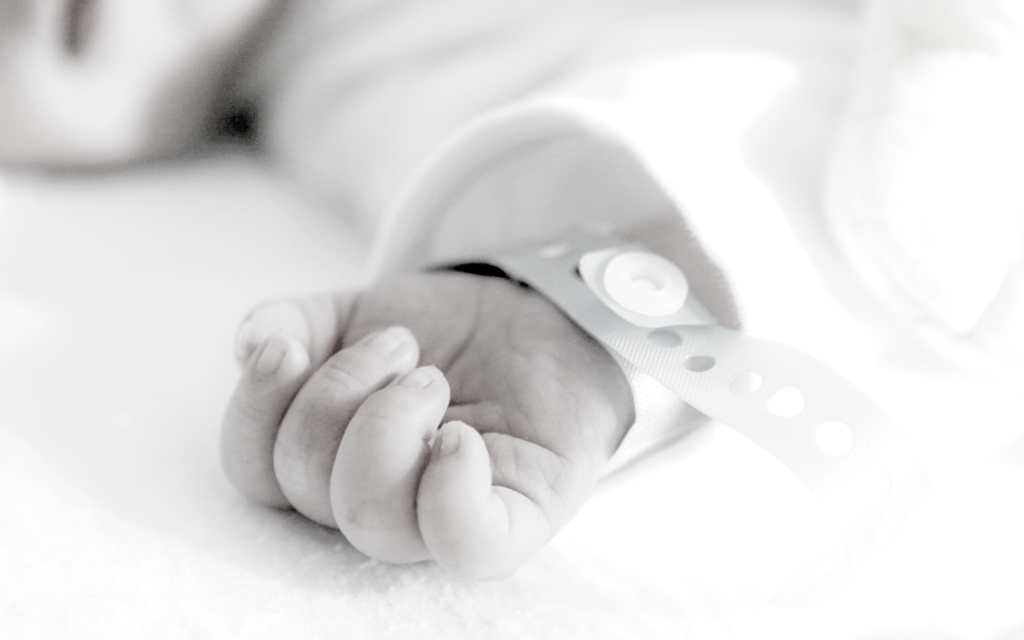A diagnosis of HIE changes a baby’s life forever. Families are affected too. They’re on an isolating journey in which the people around them may have never heard of HIE, let alone understand it. This is why HIE awareness is so important. It can offer these families a sense of community, and connect them to resources for navigating the uncertainties that come with HIE.
Whether you have a child with HIE or know someone who does, we hope this article empowers you with the knowledge and resources you need to support your loved ones. Topics you’ll find here include:
- HIE causes
- HIE signs and symptoms
- Information about HIE Awareness Month
- HIE resources and support groups

What is HIE and What Causes it?
Hypoxic Ischemic Encephalopathy, or HIE, is a condition that happens when a baby’s brain doesn’t get enough oxygen and blood. This can happen during childbirth, often because of problems with the placenta or the umbilical cord. When the brain doesn’t get oxygen, its cells can get damaged.
Hypoxic Ischemic Encephalopathy is a long name, so let’s break it down into smaller parts:
- Hypoxic: Lacking oxygen
- Ischemic: Restricted blood flow
- Encephalopathy: Brain dysfunction
Various adverse events during pregnancy and childbirth can cause HIE. Sometimes the cause is unknown. Potential causes include:
- Prolonged delivery
- Compressed or pinched umbilical cord
- Prolapsed umbilical cord
- Placental problems
- Maternal health conditions, like low blood pressure
- Infections
What are the Signs of HIE in Babies?
The lack of oxygen during birth can cause many problems for infants. Even just a few minutes without oxygen can damage the brain. So babies with HIE might show signs such as:
- Sleepiness
- Floppiness and weak muscles
- Seizures
- Problems feeding
- Difficulty breathing
- Unresponsive to stimuli
If doctors notice signs of brain damage, they should run tests to diagnose HIE as soon as possible. Timely treatment can minimize the impact on the baby’s brain development.

What’s the Treatment for HIE?
As any HIE Awareness advocate will tell you, early intervention is key to better outcomes for babies with HIE. There’s no time to lose when a baby’s brain is deprived of oxygen. And one of the earliest and best interventions a hospital can provide is called therapeutic hypothermia.
During therapeutic hypothermia or cooling therapy, the medical team lowers the baby’s body temperature little by little until it reaches about 33.5 degrees Celsius (92.3 degrees Fahrenheit). They keep the baby at this temperature for about 72 hours. Then, they gradually re-warm the baby’s temperature until it’s normal again.
This cooling process has to be done right after the baby is born. It’s most beneficial during the first six hours of life. It helps reduce inflammation and limit damage to the brain caused by the lack of oxygen during birth. In severe cases, it may save the baby’s life.
Other treatment methods for HIE include:
- Controlling seizures with medication
- Providing oxygen
- Managing other complications with medication or therapy
How Common is HIE? And What Are the Severity Levels?
According to the Hope for HIE foundation, there are 2-3 babies with HIE out of every 1,000 babies born. It’s more common in preterm babies, occurring in up to 60% of preemie births.
Part of HIE awareness is understanding that babies with HIE can have different symptoms. The level of severity affects the prognosis.
The three levels of HIE are:
- Mild HIE: Most babies with mild HIE don’t have long-term disabilities.
- Moderate HIE: Some babies with moderate HIE die early in life. 25-75% will have disabilities.
- Severe HIE: 75% of babies with this type of HIE die early in life or have a severe disability.

When is HIE Awareness Month? And HIE Resources for Parents
April is HIE awareness month. Each year, Hope for HIE hosts both physical and online events to spread awareness about HIE in local and global communities. You can find information about getting involved with HIE Awareness Month, here.
Parents of children with HIE need support, too! Equipped with knowledge about their child’s condition, they will be better able to cope with the challenges of HIE. See the sources below for further information about HIE:
Dealing with a complicated injury can be emotionally burdensome. But the support of others who are “in the same boat” can help lighten the emotional load. With this in mind, here are some HIE support groups for parents:
- Hope for HIE Facebook Support Group
- Coping with HIE Facebook Support Group
- Newborn Brain Cooling Facebook Support Group (for parents of children who have undergone cooling therapy for HIE)
(Please note that Hampton & King has no affiliation with the groups above.)
In cases where a medical provider’s negligence causes HIE, parents will require legal support. They may be able to sue for the cost of the child’s past and future medical treatment, wages lost while staying with the child in the hospital, and more.
It can be difficult to pinpoint exactly how and when negligence happened. But our lawyers have reviewed thousands of HIE cases, and are experts at identifying medical malpractice. When you’re ready, give us a call to find out what your legal options are.
HIE Awareness FAQs
Yes, babies born with HIE can lead normal lives with appropriate medical care. But this is always the case. Children with HIE can have a wide range of outcomes that depend on many factors, such as:
– The severity of HIE (mild, moderate, severe)
– The extent of oxygen deprivation
– How quickly the child received medical treatment
– Effectiveness of medical treatment
The most common cause of HIE in newborns is oxygen deprivation during childbirth. This can happen due to various factors that impact the supply of oxygen and blood flow to the baby’s brain. The primary causes include:
– Asphyxia during labor and delivery due to difficult labor, umbilical cord complications, placental issues, or maternal health conditions
– A prolapsed cord or a nuchal cord (wrapped around the baby’s neck) compromises the baby’s oxygen supply
– Placental problems such as placental abruption or placental infarction
– Low blood pressure in the mother (this can slow blood flow to the baby, leading to oxygen deprivation.)
– Infections in the mother, particularly those affecting the uterus or amniotic fluid
Congenital heart defects or other cardiovascular problems in the baby
The life expectancy of someone with HIE varies based on how severe their brain injury is. The medical treatment they receive, how fast they receive it after birth, and the presence of associated complications can also impact their life span. For 20% to 50% of infants, HIE is fatal. 25% to 60% have lifelong neurological conditions like cerebral palsy. Babies with severe HIE are the ones most likely to pass away shortly after birth.




